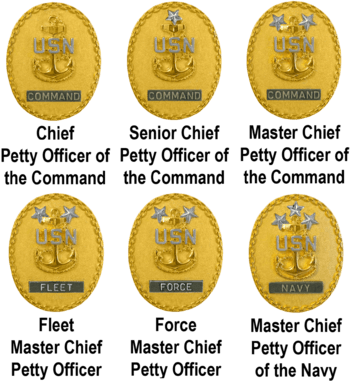CPO command identification badge

Chief petty officer (CPO) command identification badges are special United States Navy and United States Coast Guard badges which are issued to the most senior chief petty officer in a given U.S. Navy or U.S. Coast Guard command. The command may either be a shore or surface unit.[1][2]
CPO command identification badges are usually worn on the lower left pocket of a Navy and Coast Guard uniform, for male personnel, and above the right pocket and nametag for female personnel.[2] On the U.S. Navy's NWU uniform, the badge is worn on the left pocket flap for both male and female personnel, the only such U.S. Navy uniform to do so.
Navy CPO identifications are considered temporary identification badges only and are surrendered at the termination of the assignment for which they are held. Coast Guard CPO command identification badges are permanent awards. However, if a CPO is not currently filling a billet defined by the CPO identification badge they have earned, it is worn on the lower right pocket of the Coast Guard uniform.[1][2]
United States Navy
The appearance of the CPO command identification badge is determined by the rank of its holder and the level of the command in which they serve. At the single command level, the badge is issued with word “Command” on its face with a chief petty officer anchor showing the fouled anchor insignia of the bearer. E-7 CPOs display the anchor, senior chief petty officers the anchor with star and master chief petty officers the anchor with two stars.[1]
At higher Navy commands, the designation of “Fleet” and “Force” is displayed instead of “Command” indicating the senior enlisted member of an entire Navy fleet or task force. Holders of this badge are always command master chief petty officers.[1]
The highest CPO identification badge of all is the Master Chief Petty Officer of the Navy badge held solely by the Master Chief Petty Officer of the Navy.[1]
United States Coast Guard

Just like the U.S. Navy, the appearance of the U.S. Coast Guard's CPO command identification badge is determined by the rank of its holder and the level of the command in which they serve. Unlike the Navy, the Coast Guard has two general categories of CPO command identification badges which can be distinguished by their metallic color, silver or gold.[2]
Silver Coast Guard CPO command identification badges represent non-designated command positions while gold Coast Guard CPO command identification badges are commandant-designated command positions. Non-designated command badges can be found at the unit and command level at pay grades E-7 through E-9. The higher commands are always commandant-designated command positions at the command, area, rating force master chief, Master Chief Petty Officer of the Coast Guard Reserve Force (MCPO-CGRF), and Master Chief Petty Officer of the Coast Guard level. All commandant-designated command positions are at the command master chief petty officer pay grade.[2]
Prior to the release of the U.S. Coast Guard's March 2012 uniform regulation (M1020.6G), the Coast Guard awarded/issued non-designated sector CPO Command identification badges to the senior most CPO of a Coast Guard sector. Due to the removal of this badge from M1020.6G, it is assumed that the sector CPO command identification badges are no longer awarded/issued but may still be worn by those CPOs that have previously earned them.[3][4]
See also
- Coast Guard command enlisted identification badge
- Senior enlisted advisor
- Badges of the United States Navy
- Badges of the United States Coast Guard
- Obsolete badges of the United States military
References
- 1 2 3 4 5 United States Navy (25 March 2015). "Identification Badges". Uniform Regulations, chapter 5, section 5101. Archived from the original on April 28, 2016. Retrieved 28 April 2016.
- 1 2 3 4 5 United States Coast Guard (April 2013). "COMDTINST M1020.6H" (PDF). United States of America: United States Department of Homeland Security. p. 3-92. Retrieved 28 April 2016.
- ↑ U.S. Coast Guard COMDTINST M1020.6G; dated March 2012; last accessed 29 September 2013
- ↑ U.S. Coast Guard COMDTINST M1020.6F; dated February 2009; last accessed 24 February 2013

